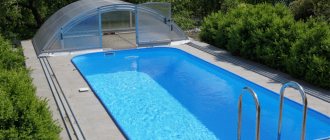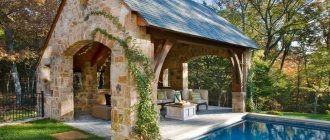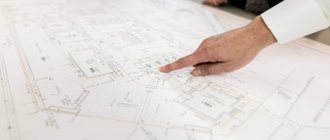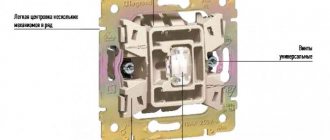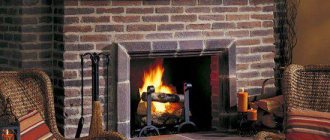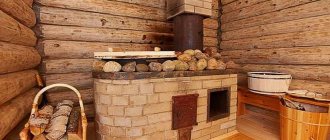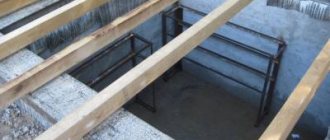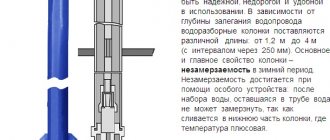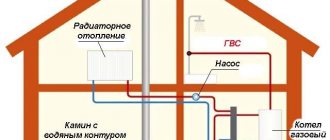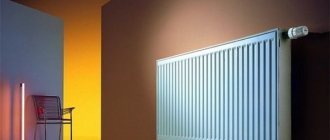In giving an unusual appearance to the facade of a brick house, Bavarian masonry has no equal. An unusual decorative effect is created by alternating finishing elements of various colors and shades. Such architectural structures gain special charm due to their historical component - buildings decorated in this way are perceived as ancient.
House lined with Bavarian brick Source fasad.guru
History of the technology
The Bavarian masonry technique as a specific type of wall construction originated in Germany in the 17th century. Houses of this type are recognizable, known everywhere from much earlier times. The reason for their appearance is considered to be the imperfection of the technology for creating and firing bricks.
Previously, building materials were produced in small batches; the elements of individual “supplies” did not resemble each other in appearance. The masons alternated them in a free order, somewhat chaotically, to avoid the appearance of large uniform spots of different shades. The joint arrangement of excellent-looking bricks, scattered, made it possible to obtain smooth color transitions across all surfaces of the structure, recognizable motley walls, which became the hallmark of the style.
Bavarian masonry in the old style involves placing bricks of different shades randomly Source konkrit.ru
In the past, the goal of craftsmen was to create surfaces that were as uniform in color as possible. The houses of wealthy citizens were covered with plaster, but poor people could not afford such luxury. Today, especially with the country spirit coming into fashion, to achieve the desired effect of antiquity, architects deliberately purchase batches of bricks that differ in appearance in tone and texture.
Features of a German-style house
The Bavarian or German style of the house presupposes neatness and even some asceticism in the external design. Its characteristic features include:
- lack of lush decorative elements;
- strictness of lines;
- practicality;
- use of inexpensive materials in finishing;
- calm color scheme.
Every element of the house must comply with these rules. Despite its apparent simplicity, while respecting the traditions of Western European architecture, the building does not look inconspicuous. Country cottages in the German style resemble fairy-tale houses straight from the pages of fairy tales. This effect is enhanced by the neat design of the local area - trimmed lawns, decorative plantings near the porch, hedges.
Walls and roof
When it comes to traditional German house style, the most common building shape is a rectangle or square. The walls are made smooth and painted in discreet colors - white, sand, gray. The combination of dark wood (timber) and clay is popular; the façade can also be decorated with polymer panels, cement-bonded particle boards or brick. The base is often finished with natural stone.
The roof of a Bavarian-style house is usually gable, without an attic and with wide overhangs. Acceptable colors include red, brown, green, blue shades and their variations. Sometimes several similar tones are combined in one coating.
The roofing material is tiles or natural slate (slate). If the house is two-story, there may be an attic under the roof with a fence made of tinted wood, a bay window or a balcony.
Windows and doors
The entrance lobby and windows, decorated in German style, should attract attention. The door itself is usually wooden, with glazing and lintels in the upper part.
A porch, wooden or stone, leads to the entrance to the building. There can also be a spacious veranda in front of the door.
Windows are usually rectangular or arched in shape. Each of them consists of several square or rectangular sections connected by jumpers. Modern Bavarian style also allows for panoramic glazing of houses.
If this is combined with the overall style of the facade, the windows can be complemented with shutters. They perform decorative functions, creating a bright accent and giving the house a rustic, cozy look. Sometimes shutters are covered with carvings and paintings.
Basic rules for arranging Bavarian masonry
Independent execution of Bavarian masonry at home requires compliance with established rules.
- It is important to “color” adjacent blocks in different colors. Bricks that are completely identical in appearance should not have common boundaries.
Only bricks that differ in appearance can be directly adjacent Source stroyportal.ru
- The alternation of shades on the finished wall should look chaotic; the appearance of areas with a predominance of one color or another, as well as tone (bright, dull, light or dark), is unacceptable.
- The resulting pattern should also appear chaotic, have unfinished lines, and be characterized by the absence of a periodically repeating pattern.
- None of the shades used should create an accent against the background of the others.
- The selected proportion in the ratio of tones must be observed throughout the entire masonry.
The technique for implementing masonry work itself remains standard. They are carried out in such a way that the vertical seams strictly coincide in one row.
Vertical seams must clearly coincide across the row Source donstroykomplekt.rf
The greatest difficulty is in developing the pattern. To prepare a competent project, you can use convenient technology. About 10–12 masonry templates are created in paper or electronic form (using a graphic editor). All of them must demonstrate different alternations of shades intended for use in the same proportions chosen once.
After preparation, the resulting patterns are mixed with each other, combining randomly. As a result, on the scale of an entire structure, combinations of individual elements, patterns and colors will be completely chaotic, but the balance of tones will be maintained perfectly.
Bavarian masonry technology is used primarily for cladding the facades of residential, administrative buildings, and other structures. It is also applicable for the construction of fences, brick fences, small architectural forms (gazebos, bus stops), and individual decorative and functional elements.
Individual structures made of Bavarian masonry look holistic and unusual Source msk-kamin.ru
Within the framework of this technique, a wide variety of masonry designs can be realized. Traditional spoon masonry, “savage”, looks especially good in this design. In the second case, a similar type of construction will be added to the unique, seemingly random mixture of shades, since the alternation of spoons and pokes will also be arbitrary.
It is permissible to use smooth, rough, or otherwise textured bricks as raw materials. Before construction begins, the material is sorted according to its appearance.
Color selection
It is very important to choose colors in advance. Experts recommend first deciding on the main color of the object.
And only then a secondary one is chosen to join it, it is either contrasting to the main one, or close to it. It all depends on the layout of the facility as a whole. Next, the remaining shades are selected in the required quantity, which are close to the first two. When choosing the color of bricks, you need to foresee the color of the joints in the masonry; it is this that affects how the structure will look in the future.
Often, manufacturers immediately offer a certain color range of materials and immediately a certain color of mortar for joints. Remember that the color of the walls should be harmoniously combined with the material and shade of the roof.
The picture should not be repeated. Color should be distributed in such a way as to create the impression of chaos, but it should be well thought out.
It is very important that the bricks are of high quality. However, some builders, either due to a desire to save money or due to lack of experience, purchase low-quality material
You can check it like this: take several samples before purchasing and place them one by one with all their edges against each other. Check the variations in sizes and the gaps between them. However, if you were unable to check in advance and have already purchased low-quality material, then you need to treat its masonry with special care.
Modern versions of Bavarian masonry
The execution of classic Bavarian masonry requires the participation of four colors:
- dark red;
- dark brown;
- light red;
- light brown.
It is possible to use more colors (up to nine). To highlight the beauty of the variegated pattern, the prominent parts of the building structure (corners, columns, cornices) are isolated using a single-color cladding.
Modern compositions in most cases are made using dark shades of fired clay, close to natural ones. They allow you to create solid buildings that are impressive in their appearance. Light combinations are used less often. Experienced masons often turn to spectacular herringbone masonry.
Bavarian masonry in dark shades allows you to combine the requirements of modernity with the spirit of antiquity, creating real works of art Source youtube.com
Another popular combination is the combination of Bavarian and two-tone masonry houses. In this case, corners, window and door openings are decorated in lighter shades, and the main surface of the walls is laid out with red brick and blocks similar in color.
Most modern craftsmen do not strive to thoroughly work out the lines of the future pattern at the preparatory stage of work. In a simplified version, a stylish design requires only three shades of brick, one of which becomes the main one. It is this that is included in the estimate in the amount of 50%, the rest is purchased in an arbitrary proportion.
It is clear that the requirement that blocks of the same shade should not come into contact with each other in this case will not be met. To improve the appearance of the building when choosing this construction method, you can purchase a colored solution.
Combined bricklaying with colored mortars Source brick-vologda.rf
Choosing an ornament
drawing of bavarian masonry
In order to truly lay out a Bavarian masonry pattern, you must adhere to certain rules:
- strictly maintain the proportions of elements;
- the predominance of bright colors in certain places is unacceptable;
- it is possible to alternate oblong and short sides of the brick;
- You can use bricks with both a smooth and ribbed surface.
To create a truly unique design, the likes of which will be difficult to find, it is necessary to make all the “in-your-face” pokes in black. At your discretion, any number of pokes are laid out completely, then the same arbitrary number of spoons. In this case, bricks should be taken from different pallets in turn. In this case, the pattern will come out fairly evenly placed on the surface. Bricks with black pokes can be 50/50 of the total amount of material used, and with black spoons up to 1/10. The masonry procedure itself is absolutely identical to the classic version.
How to choose material
To line the walls of a building with Bavarian masonry, you need to purchase pallets of multi-colored blocks, preferably to order. Despite the standardization of production, batches of material from different factories may differ. The entire volume of brick required for construction must be calculated in advance.
To select high-quality raw materials for the construction of walls, you will need to take into account all its key characteristics.
- Each brick must have a uniform color. Disadvantages of this kind will bring disharmony into the overall picture of the finished masonry.
- Damage (chips, cracks, deep scratches) is not allowed. Such material will not last long and will make the building unsafe.
A good quality facing brick should have the correct shape without scratches or chips Source kirpichyar.ru
- The reputation of the plant is of particular importance. Only a conscientious manufacturer can offer a high-quality, durable product.
- The technical parameters of the brick required for Bavarian masonry are as follows: frost resistance class not lower than F50, strength grade not less than M150, moisture absorption level of about 8–10%. The physical properties of the material should allow it to be used for the construction of highly loaded architectural elements.
Large manufacturers can offer their customers ready-made batches of so-called Bavarian bricks. The building material is created using a special annealing technology to give its front decorative surface a certain color. Complex manufacturing techniques raise the cost of finished products, but make them ideal for the task at hand.
Building blocks for Bavarian masonry today are produced using a special technology Source ugstroys.ru
Slavic brick factory Krasnodar region
The plant is equipped with modern German equipment with high productivity. Production is carried out using plastic forming technology. Collections of façade ceramic bricks are distinguished by their unique style and new color schemes, giving the building a presentable appearance and bright individuality.
Hollow brick is presented only in the standard 1 SF format. The manufacturing technology uses the engobing method (applying a thin layer of white or colored clay with additives and dyes to the surface), which increases decorativeness and reduces water absorption to 8%. In addition, Slavic facing brick is characterized by increased strength (M200).
The Bricus catalog presents the following interesting collections: Provence (shades of blue), Hamburg (gray), Gothic and Milan.
- Provence smooth with engobing (unusual blue-violet color);
- Provence RUST (rustic surface with shallow wrinkles, less bright color compared to Provence);
- Provence BUNT ANTIQUE (gradient red-blue color, rustic surface with sand);
- Provence ANTIQUE (differs from the previous type only in its uniform blue color);
- Provence BUNT RUST (distinguished by the gradient color of the brick with a transition from red to blue);
- Hamburg RUST (has a gray background and a rustic surface);
- Hamburg BUNT (gradient color with a transition from dark gray to yak brown, smooth surface);
- Hamburg BUNT RUST;
- Gothic ANTIQUE (rustic surface with sand);
- Gothic smooth (bright combination of contrasting colors);
- Milan with engobing (each brick is unevenly painted in several colors, smooth surface);
- Milan with engobing taupe (smooth surface).
The retail price for the manufacturer's product does not exceed 20 rubles per piece, which makes the product very attractive, especially for cladding a private house.
Recommendations for laying Bavarian bricks
After purchasing building material of the required quality and preparing a sketch, you can finally begin the most significant stage of the work, the masonry itself. As an example, we can consider the most popular use of Bavarian brick - creating cladding.
Checking the verticality of the walls
The geometry of the facades is checked with a plumb line. The position of vertical partitions is studied everywhere; the approximate line of location of the future cladding is indicated on the foundation.
If it is planned to carry out wall insulation in parallel with the main work, a gap is left between the base partition and the cladding no less wide than the thickness of the additional structural element that reduces heat transfer. If it is absent, the gap should be as small as possible; the free space will need to be sealed with mortar.
Facade cladding can be successfully combined with work on its insulation Source vevanta.com
First steps
After marking, they begin to lay out the first line of blocks, it is desirable that they all turn out to be solid. The movement begins from one corner to the next, the gap between the individual elements should be no more than 0.1 cm.
In order for all the component blocks of the first level to remain intact, the distances between them can be slightly increased, widening the gaps within 3 mm. This technology allows you to develop up to 100 mm of space in 25 bricks. If trimming still turns out to be necessary, the remaining piece will have to be set aside for arranging inconspicuous parts of the masonry.
Preparatory work
It will take a lot of time to fully prepare the workspace.
- An area of the required size near the main wall is made completely accessible by removing construction and other debris and pushing away unnecessary objects.
To ensure quality work, the space in front of the house must be carefully prepared. Source chastnydom.com
- Scaffolding is mounted to the wall, they are made independently from wood or ready-made products are taken from rolled metal. The second option is preferable, since it allows for complete safety of the master and speeds up the completion of work.
- The masonry mortar is made somewhat thicker than usual to eliminate the risk of slipping of the non-hygroscopic Bavarian brick. Cement and sand are mixed in a ratio of 1:4, water is added as needed.
- Waterproofing is placed on the foundation. To achieve the desired result, a couple of layers of roofing material are enough.
Preliminary laying begins from both corners opposite to each other. It must be raised to 5 rows, continuously monitoring the geometry of the joints. The best control tool is a plumb line, but the level makes it possible to accumulate errors, which in the future will inevitably create intractable difficulties.
Basic classification of paints
Read the instructions on the packaging carefully. It usually describes in detail recommendations on the method of applying the composition.
The title side must indicate:
- façade paint (they are the most resistant to adverse effects);
- for interior work (without harmful fumes, they are practically harmless, even latex ones, due to the solvent-free composition).
The same paint is rarely used on the outside of the house and inside, since they have different performance characteristics.
Solvent-based paints and varnishes have a persistent chemical odor
You need to be careful with them - work only with a respirator and other protective equipment.
Additional recommendations
The main difficulty of performing Bavarian facing masonry becomes obvious when arranging the openings.
- If there is a need to reduce the length of the brick, you should use a grinder equipped with a diamond disc. “Trimming” is not used in the corners of the structure.
- In order for the cladding to be securely fixed, it is “tied” to the load-bearing vertical partition using cellular metal products, a profile or galvanized perforated tapes. The fasteners are fixed to the base wall using dowels.
- Metal corners are used to cover window and door openings. First, a mortar is applied to their horizontal surface, then a brick cut along the inner corner is laid on it. The laying is carried out along a thread pre-tensioned in a strictly horizontal position.
Window and door openings require special attention when performing Bavarian masonry. Source iz-kirpicha.su
If the fasteners lie unevenly, you should not devote time to adjusting its geometry. Bricks are a heavy enough material to press the rolled metal and fix it in the required position.
Italian (Mediterranean) garden design style
Italian style is colorful and popular. For its implementation, subtropical vegetation is used. This landscape is ideal for the southern regions of Russia, where the climate is moderately mild and warm. The following nuances are considered to be the features of this direction:
- Successfully organized on relief terrain. The Mediterranean style of courtyard design looks good on slopes and uneven ground surfaces.
- Using plants with lush crowns, colorful and picturesque flowers. The predominant shades are blue, light blue, green, sand, orange, azure.
- Among the materials used to organize the exterior are: sand, natural stone, pebbles. If furniture is provided in the garden, it is made of artificial rattan and is complemented with decorative pillows in cases that match the color of the design.
- This style welcomes the cultivation of palm trees, citrus fruits and olive trees. Decorative spruce and juniper trees also look beautiful. They will dilute the colorful atmosphere with their shade. The crowns of these crops are carefully trimmed. If there are arches in the yard, they can be decorated with wild climbing grapes or one of the varieties of ivy.
- Additional decorations and accessories are required: forged elements, garden figures, benches, amphorae and other decorative objects. Metal and ceramics are a great combination in Italian landscape style.
Dutch style landscaping with many colorsSource rehouz.info
Decorating the backyard with flower beds with bulbous perennialsSource rehouz.info
Dutch design in the exterior of the local areaSource build-experts.ru
Dutch exterior style near a private houseSource domnomore.com
Backyard design in Dutch landscape styleSource modernplace.ru
Classic or French style of landscape design
This direction is recognized as the most popular. Suitable for large yard areas. Characterized by strict lines, simplicity and conciseness. Central objects on the territory must be selected: gazebos, small ponds, decorative structures. They are usually installed at the intersection of wide paths leading from the yard. The main features of the landscape design style are:
- Strict symmetry. This can be seen in the decorative vegetation: neatly and uniformly trimmed bushes, flowers of the same height, evenly shaped flower beds and rock gardens.
- An unusual way of planting plants: an even ladder, in the form of a geometric frame, sowing squat, small-flowering plants. Such a composition always has a center.
- Choose trees and shrubs whose shape can be easily corrected. The object is made spherical, pyramidal, triangular, cubic.
- Traditionally, coniferous crops are used: juniper, cypress, thuja, and ornamental blue spruce. Linden, hawthorn, and fruit crops are also used to decorate the site.
- Tall trees are planted along paths and paths. If a separate area is provided, then all crops are placed in a chaotic order.
The main feature of the classic exterior solution is constantly flowering plants.
Classic style of yard landscape designSource rehouz.info
Classic design in the courtyard with a small fountainSource yandex.ru
Zoning in classical style landscape designSource fermer.blog
